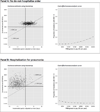The cost-effectiveness of the decision to hospitalize nursing home residents with advanced dementia
- PMID: 23571207
- PMCID: PMC3708971
- DOI: 10.1016/j.jpainsymman.2012.11.007
The cost-effectiveness of the decision to hospitalize nursing home residents with advanced dementia
Abstract
Context: Nursing home (NH) residents with advanced dementia commonly experience burdensome and costly hospitalizations that may not extend survival or improve quality of life. Cost-effectiveness analyses of decisions to hospitalize these residents have not been reported.
Objectives: To estimate the cost-effectiveness of 1) not having a do-not-hospitalize (DNH) order and 2) hospitalization for suspected pneumonia in NH residents with advanced dementia.
Methods: NH residents from 22 NHs in the Boston area were followed in the Choices, Attitudes, and Strategies for Care of Advanced Dementia at the End-of-Life study conducted between February 2003 and February 2009. We conducted cost-effectiveness analyses of aggressive treatment strategies for advanced dementia residents living in NHs when they suffer from acute illness. Primary outcome measures included quality-adjusted life days (QALD) and quality-adjusted life years, Medicare expenditures, and incremental net benefits (INBs) over 15 months.
Results: Compared with a less aggressive strategy of avoiding hospital transfer (i.e., having DNH orders), the strategy of hospitalization was associated with an incremental increase in Medicare expenditures of $5972 and an incremental gain in quality-adjusted survival of 3.7 QALD. Hospitalization for pneumonia was associated with an incremental increase in Medicare expenditures of $3697 and an incremental reduction in quality-adjusted survival of 9.7 QALD. At a willingness-to-pay level of $100,000/quality-adjusted life years, the INBs of the more aggressive treatment strategies were negative and, therefore, not cost effective (INB for not having a DNH order, -$4958 and INB for hospital transfer for pneumonia, -$6355).
Conclusion: Treatment strategies favoring hospitalization for NH residents with advanced dementia are not cost effective.
Keywords: Advanced dementia; cost-effectiveness analysis; health care expenditures; nursing home residents; quality of life.
Copyright © 2013 U.S. Cancer Pain Relief Committee. Published by Elsevier Inc. All rights reserved.
Conflict of interest statement
None of the authors had any conflicts of interest in preparing this manuscript. Two authors (Goldfeld and Mitchell) had full access to all the data in the study and take responsibility for the integrity of the data and the accuracy of the data analysis.
Figures


Similar articles
-
Health insurance status and the care of nursing home residents with advanced dementia.JAMA Intern Med. 2013 Dec 9-23;173(22):2047-53. doi: 10.1001/jamainternmed.2013.10573. JAMA Intern Med. 2013. PMID: 24061265 Free PMC article.
-
Hospital transfers of nursing home residents with advanced dementia.J Am Geriatr Soc. 2012 May;60(5):905-9. doi: 10.1111/j.1532-5415.2012.03919.x. Epub 2012 Mar 16. J Am Geriatr Soc. 2012. PMID: 22428661 Free PMC article.
-
Decisions to hospitalize nursing home residents dying with advanced dementia.J Am Geriatr Soc. 2005 Aug;53(8):1396-401. doi: 10.1111/j.1532-5415.2005.53426.x. J Am Geriatr Soc. 2005. PMID: 16078968
-
Medicare expenditures among nursing home residents with advanced dementia.Arch Intern Med. 2011 May 9;171(9):824-30. doi: 10.1001/archinternmed.2010.478. Epub 2011 Jan 10. Arch Intern Med. 2011. PMID: 21220646 Free PMC article.
-
Should I hospitalize my resident with nursing home-acquired pneumonia?J Am Med Dir Assoc. 2005 Sep-Oct;6(5):327-33. doi: 10.1016/j.jamda.2005.06.005. J Am Med Dir Assoc. 2005. PMID: 16165074 Review.
Cited by
-
Association of Nursing Home Organizational Culture and Staff Perspectives With Variability in Advanced Dementia Care: The ADVANCE Study.JAMA Intern Med. 2022 Mar 1;182(3):313-323. doi: 10.1001/jamainternmed.2021.7921. JAMA Intern Med. 2022. PMID: 35072703 Free PMC article.
-
End-of-Life Care Interventions: An Economic Analysis.Ont Health Technol Assess Ser. 2014 Dec 1;14(18):1-70. eCollection 2014. Ont Health Technol Assess Ser. 2014. PMID: 26339303 Free PMC article. Review.
-
Where's the evidence? a systematic review of economic analyses of residential aged care infrastructure.BMC Health Serv Res. 2017 Mar 21;17(1):226. doi: 10.1186/s12913-017-2165-8. BMC Health Serv Res. 2017. PMID: 28327120 Free PMC article.
-
Goals of Care or Goals of Trust? How Family Members Perceive Goals for Dying Nursing Home Residents.J Palliat Med. 2017 Apr;20(4):360-365. doi: 10.1089/jpm.2016.0271. Epub 2016 Nov 29. J Palliat Med. 2017. PMID: 27898281 Free PMC article.
-
Dying comfortably in very old age with or without dementia in different care settings - a representative "older old" population study.BMC Geriatr. 2017 Oct 5;17(1):222. doi: 10.1186/s12877-017-0605-2. BMC Geriatr. 2017. PMID: 28978301 Free PMC article.
References
-
- Murphy SL, Xu J, Kochanek KD. Deaths: preliminary data for 2010. Natl Vital Stat Rep. 2011;60:1–68. - PubMed
-
- Mitchell SL, Kiely DK, Hamel MB. Dying with advanced dementia in the nursing home. Arch Intern Med. 2004;164:321–326. - PubMed
-
- Di Giulio P, Toscani F, Villani D, Brunelli C, Gentile S, Spadin P. Dying with advanced dementia in long-term care geriatric institutions: a retrospective study. J Palliat Med. 2008;11:1023–1028. - PubMed
-
- Mitchell SL, Teno JM, Miller SC, Mor V. A national study of the location of death for older persons with dementia. J Am Geriatr Soc. 2005:299–305. - PubMed
Publication types
MeSH terms
Grants and funding
LinkOut - more resources
Full Text Sources
Other Literature Sources
Medical

